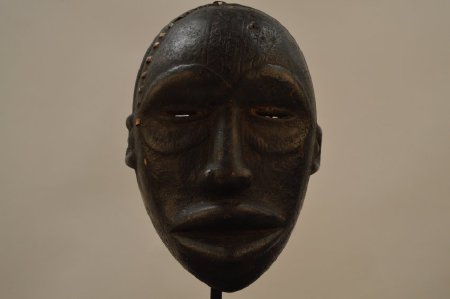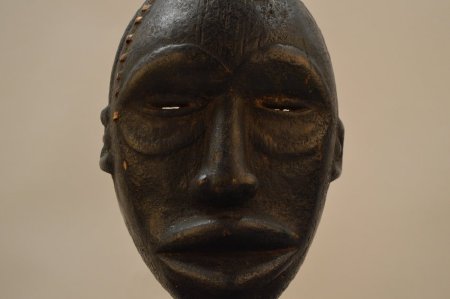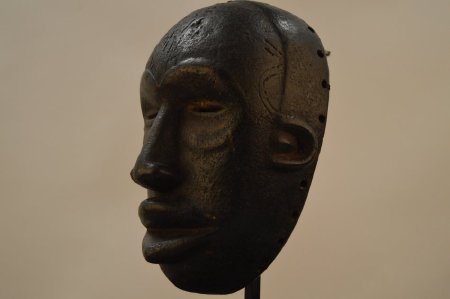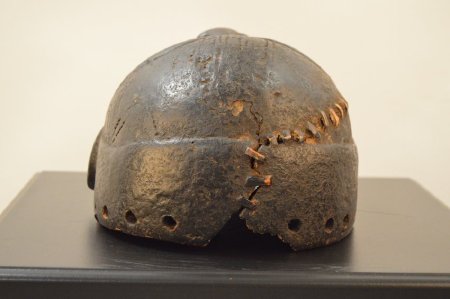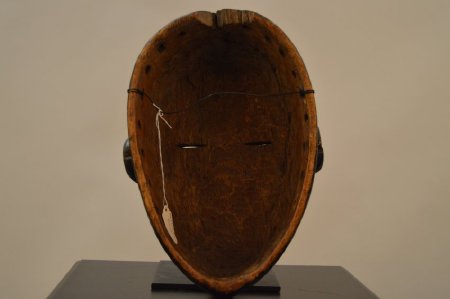Title:
Dan Dance Mask
Object Name:
Mask, Dance, Ritual
Other Name:
Mask, Dance, Face, Dan
Place of Origin:
Northern Dan, Guinea / Ivory Coast, Africa
Provenance:
Aboriginal Indigenous Art.
H = 13"
W = 9"
D = 6"
Dan people have achieved notoriety for their entertainment festivals, which were village ceremonies, but are today performed largely for important visitors. During these festivals, masked performers dance on stilts. The go master, the head of the like—named society possesses the masks and guards them in a sacred hut. All Dan masks are sacred; they do not represent spirits of the wilderness, they are these spirits. Dan masks are characterized by a concave face, a protruding mouth, high—domed forehead and are often covered in a rich brown patina. There are a variety of Dan face masks, each of which has a different function. They may be the intermediaries, who acts between the village and the forest initiation camp, may act against bush fires during the dry season, used in pre—war ceremonies, for peace—making ceremonies, for entertainment. Over time, many among them have lost their original function and have been recycled into contexts related to entertainment, emerging only for festivals or events organized for visitors. Nonetheless, the great masks live on, their even more rare appearances being reserved for times of tension, when it is important they may exercise their role of social control and their faculty to reduce conflict or settle legal wrangles.
H = 13"
W = 9"
D = 6"
Dan people have achieved notoriety for their entertainment festivals, which were village ceremonies, but are today performed largely for important visitors. During these festivals, masked performers dance on stilts. The go master, the head of the like—named society possesses the masks and guards them in a sacred hut. All Dan masks are sacred; they do not represent spirits of the wilderness, they are these spirits. Dan masks are characterized by a concave face, a protruding mouth, high—domed forehead and are often covered in a rich brown patina. There are a variety of Dan face masks, each of which has a different function. They may be the intermediaries, who acts between the village and the forest initiation camp, may act against bush fires during the dry season, used in pre—war ceremonies, for peace—making ceremonies, for entertainment. Over time, many among them have lost their original function and have been recycled into contexts related to entertainment, emerging only for festivals or events organized for visitors. Nonetheless, the great masks live on, their even more rare appearances being reserved for times of tension, when it is important they may exercise their role of social control and their faculty to reduce conflict or settle legal wrangles.
Description:
Oval—shaped wooden face mask, with long protruding triangular—shaped nose and large nostrils. Circular concave eye sockets, with pierced slit eyes. Large full lips with slightly open mouth. Small C—shaped ears. Possible scarification marks on forehead and top right side of face. Large chip and crack, starting in the very top center of head, continuing down the right side of face to corner of right eye. Repaired with what appears to be raffia stiching, (or some form of natural substance). Black patina covering entire surface.
Collection:
Guy Mace Collection, (Turblex Company)
Material:
Wood W/Patina
Used:
Ritually Used
Technique:
Carving / Painting
Owned:
Art Department, Missouri Southern State University
Accession#:
2015.2.12
